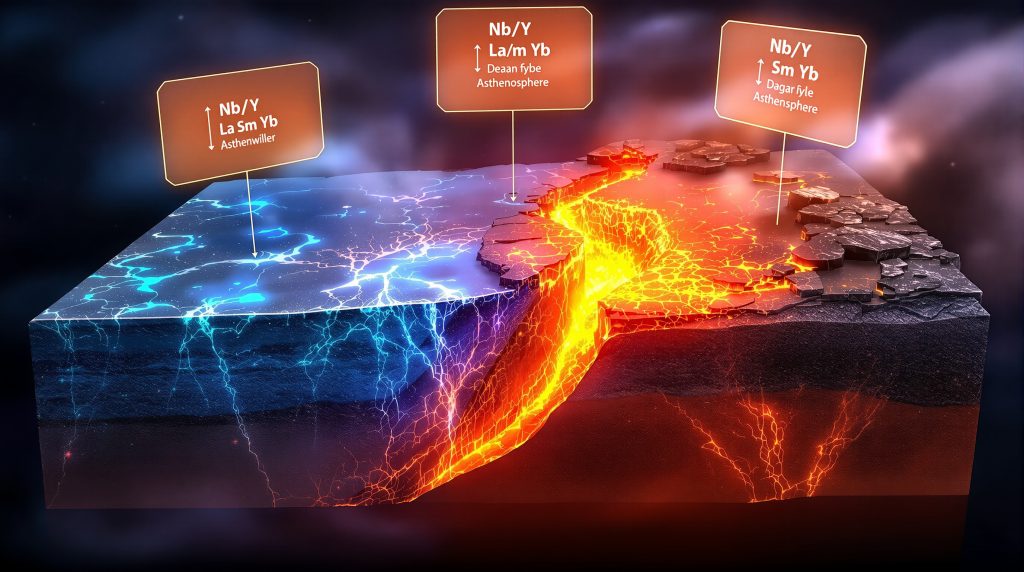Understanding Postcollisional Slab Breakoff Magmatism
Postcollisional slab breakoff magmatism represents a critical tectonic-magmatic phenomenon that occurs after continental collision events. This process involves the detachment of a subducting oceanic lithospheric slab beneath a convergent plate boundary, creating distinctive magmatic signatures that differ significantly from typical arc magmatism. The breakoff event triggers asthenospheric upwelling, which provides the heat necessary to generate partial melting in the overlying lithospheric mantle.
Understanding this phenomenon is crucial for geologists working on ancient orogenic belts, as it provides key insights into mineral exploration insights and the evolution of mountain-building processes and their associated magmatic expressions.
Timing and Tectonic Context
Slab breakoff typically occurs within 1-20 million years following the initial continental collision. This process represents a transitional phase between compressional tectonics during active collision and subsequent extensional or transtensional regimes. The timing varies considerably depending on factors such as convergence rates, slab dip angles, and the thermal state of the lithosphere involved.
In remarkable cases like the Peninsula Ranges Batholith, the transition from arc to postcollisional magmatism can occur rapidly, perhaps in less than one million years. This rapid transition suggests that under certain conditions, slab failure can happen much more quickly than previously thought, as confirmed by recent research on collision-driven magmatism.
Mechanical Processes Driving Slab Breakoff
The slab breakoff mechanism initiates when continental lithosphere enters the subduction zone, creating significant buoyancy contrasts between the dense oceanic lithosphere and the more buoyant continental material. This buoyancy difference generates tensional forces within the slab, eventually leading to necking, thinning, and complete detachment of the oceanic portion.
The detached slab sinks into the deeper mantle, creating a "slab window" that allows hot asthenospheric mantle to flow upward. This upwelling creates a distinctive thermal regime that differs fundamentally from typical subduction settings.
Thermal Effects and Magma Generation
The upwelling asthenosphere provides a significant heat source that affects:
- The base of the overlying lithospheric mantle
- Previously metasomatized (chemically altered) mantle regions
- The lower continental crust in some settings
This thermal perturbation triggers partial melting in these domains, producing magmas with distinctive geochemical signatures that reflect both their source regions and the tectonic setting.
Importantly, there is insufficient time for crustal thickening by underplating or heat transfer by conduction to melt underthrust material. Instead, the rapid nature of the process means that melting occurs through direct thermal effects of asthenospheric upwelling.
Geochemical Fingerprints of Slab Breakoff Magmatism
Postcollisional slab breakoff magmas display characteristic trace element patterns that distinguish them from typical arc magmatism. These geochemical signatures serve as powerful tools for identifying ancient collision zones in the geological record and can be documented using standardized geological logging codes.
Distinctive Trace Element Signatures
| Parameter | Arc Magmatism | Slab Breakoff Magmatism |
|---|---|---|
| Nb/Y ratio | <0.4 | >0.4 |
| La/Yb ratio | <10 | >10 |
| Sm/Yb ratio | <2.5 | >2.5 |
| Ta+Yb | Lower values | >6 for most samples |
| Nb+Y | Lower values | >60 for A-type variants |
These geochemical differences reflect fundamental variations in magma generation processes, particularly melting depth and source composition. The higher trace element ratios in postcollisional magmas indicate distinct source characteristics and melting conditions compared to arc magmas.
Silica Distribution Patterns
Slab breakoff magmas typically show a more restricted silica range (55-70 wt% SiO₂) compared to the broader compositional spectrum found in arc settings. This narrower range reflects the more homogeneous melting conditions during the breakoff event.
Rocks with >70% silica often show evidence of alteration rather than primary magmatic processes. In particular, these highly silicic rocks frequently display decreasing La/Yb ratios and Sr loss, indicating that their compositions have been modified by late-stage fluid interactions rather than magmatic fractionation.
Melting Depth: A Critical Indicator of Slab Breakoff
The depth at which melting occurs represents one of the most important discriminators between postcollisional slab breakoff magmatism and typical arc magmatism. This parameter can be effectively tracked using specific trace element ratios.
Garnet Stability and Rare Earth Element Ratios
The Sm/Yb ratio serves as a critical indicator of melting depth, with values >2.5 typically indicating deeper melting where garnet remains stable in the source region. This higher ratio in postcollisional magmas suggests:
- Deeper melting in the mantle during slab breakoff
- Garnet retention in the source, fractionating heavy rare earth elements
- Distinct thermal conditions compared to typical arc settings
This depth indicator has been validated using data from young oceanic and continental arc rocks, which consistently show Sm/Yb ratios less than 2.5, confirming their shallower source compared to postcollisional breakoff magmas.
Implications for Magma Generation Models
These depth indicators help constrain geodynamic models of slab breakoff, suggesting that magma generation occurs at greater depths than in typical subduction settings, consistent with asthenospheric upwelling following slab detachment.
The consistent relationship between melting depth and tectonic setting provides a robust framework for interpreting ancient magmatic rocks and reconstructing their tectonic environments.
Temporal-Spatial Evolution of Postcollisional Magmas
Postcollisional magmatism frequently displays systematic temporal and spatial evolution patterns that reflect the changing dynamics of the orogenic system following slab detachment.
Migration Patterns and Compositional Shifts
Common evolutionary trends include:
- Initial magmatism occurs close to the suture zone
- Progressive migration away from the suture over time
- Compositional shifts from calc-alkaline to more alkaline signatures
- Decreasing crustal contamination signatures with time
These patterns reflect the progressive thermal and mechanical evolution of the orogen following slab breakoff, as the system transitions from compressional to extensional or transtensional regimes.
Alteration Effects and Geochemical Mobility
Late-stage fluid interactions can significantly modify original magmatic compositions, particularly affecting mobile elements like Sr and Rb. This alteration presents challenges for discrimination diagrams using these elements and necessitates careful sample selection (55-70 wt% SiO₂, aluminum saturation index <1.1) to avoid misclassification.
Specifically, rocks with silica greater than 70% commonly show strontium loss, presumably due to plagioclase feldspar destruction by alteration. This behavior argues against using Sr/Y as a robust discriminator between slab failure and arc rocks, despite its effectiveness in some case studies.
Key Global Examples of Slab Breakoff Magmatism
Several well-documented examples of postcollisional slab breakoff magmatism provide insights into the global manifestations of this process across different geological and temporal contexts.
The Peninsula Ranges Batholith: A Classic Case Study
The Peninsula Ranges Batholith in Southern and Baja California provides a well-documented example of the transition from arc to postcollisional slab breakoff magmatism:
- Pre-100 Ma arc magmatism (Santa Ana suite) showing typical arc signatures
- Regional deformation at ~100 Ma marking the collision event
- Post-100 Ma magmatism (La Posta suite, 99-85 Ma) with distinctive slab breakoff characteristics
- Rapid transition between magmatic regimes (<1-2 million years)
- Clear geochemical discrimination between pre- and post-collisional suites
This batholith extends over 1,000 kilometers from just south of Los Angeles, California to Guerrero Negro in Baja California, making it one of the most extensive examples of postcollisional magmatism worldwide.
Other Significant Global Examples
Postcollisional slab breakoff magmatism has been identified in numerous orogenic belts worldwide:
- Western Anatolia (Turkey): Eocene magmatism (~54-35 Ma) following collision of the Sakarya and Tauride-Anatolide blocks, as detailed in studies of post-collision models
- Alpine-Himalayan system: Various magmatic pulses following the closure of the Tethys Ocean
- Taiwan: Young (~100,000-year-old) volcanics in the northernmost exhumed and collapsed region of the arc-continent collision zone
- Coastal Batholith of Peru: Post-100 Ma intrusions following deformation of the Lower Cretaceous Casma-Kete arc complex
These diverse examples demonstrate the global significance of postcollisional slab breakoff magmatism in orogenic systems and provide multiple perspectives on how this process manifests under different geological conditions.
Optimal Tectonic Discrimination Methods
Identifying postcollisional slab breakoff magmatism in ancient orogenic belts requires reliable discrimination methods that can distinguish these rocks from other tectonic settings, particularly arc environments.
Optimized Discrimination Diagrams
The most reliable discrimination plots for identifying postcollisional slab breakoff magmatism include:
- Nb vs. Y plot with a boundary line separating arc (<0.4) from slab breakoff (>0.4) fields
- Ta vs. Yb plot with similar discriminating power
- La/Yb vs. Sm/Yb plot highlighting the deeper melting signature of slab breakoff magmas
- Multi-element plots incorporating Nb, Y, Ta, and Yb that provide clear field boundaries
These modified discrimination diagrams improve upon earlier tectonomagmatic classification schemes by incorporating extensive ICPMS-analyzed sample suites and empirically determined boundary lines.
Limitations and Best Practices
For reliable discrimination:
- Avoid highly silicic samples (>70% SiO₂) due to potential alteration effects
- Exclude cumulate rocks (<55% SiO₂) as they don't represent magmatic liquids
- Use immobile trace elements (Nb, Ta, Y, Yb) rather than mobile elements (Sr, Rb)
- Consider multiple discrimination criteria rather than relying on a single plot
- Limit analysis to I-type granites with aluminum saturation index <1.1
Following these guidelines helps ensure that tectonic interpretations based on geochemical data are robust and reliable.
Broader Tectonic Implications of Slab Breakoff
Slab breakoff influences not only magmatic processes but also has profound effects on the broader tectonic evolution of orogenic systems, from sedimentation patterns to structural development.
Crustal Responses to Slab Detachment
Slab breakoff triggers significant crustal responses beyond magmatism:
- Rapid uplift and exhumation of the collisional hinterland
- Transition from flysch-type sedimentation to coarse molasse deposits
- Reactivation of pre-existing structures under new stress regimes
- Thermal resetting of metamorphic assemblages
In the Peninsula Ranges Batholith, for example, postcollisional plutons were emplaced contemporaneously with thick Cenomanian-Coniacian clastic successions to the west, including a rapid change from flysch-type sedimentation to coarse, cobbly, and bouldery molasse during the early Campanian.
Implications for Mineral Resources
The distinctive magmatic and structural features associated with slab breakoff create favorable conditions for various mineral deposit types:
- Porphyry copper-gold systems in the upper crustal environments
- Skarn deposits where magmas interact with carbonate country rocks
- Epithermal precious metal deposits in shallower crustal levels
- Rare earth element enrichments in some alkaline postcollisional intrusions
Understanding the relationship between slab breakoff and mineralogy and ore economics can guide exploration strategies in ancient orogenic belts.
Effective Research Approaches for Studying Slab Breakoff
Modern studies of postcollisional slab breakoff magmatism benefit from integrating multiple analytical approaches and careful sampling strategies to extract meaningful tectonic information.
Integrated Analytical Strategies
Comprehensive studies typically combine:
- High-precision geochronology to establish temporal relationships
- Detailed trace element geochemistry using ICP-MS techniques
- Isotopic analyses to constrain magma sources and contamination
- Structural analysis to correlate magmatism with deformation events
- Numerical modeling to test geodynamic scenarios
The Peninsula Ranges Batholith study exemplifies this approach, combining systematic grid sampling (334 samples collected on a uniform grid) with modern ICPMS analysis of 287 filtered samples to establish robust geochemical patterns.
Sampling Considerations
Effective characterization requires:
- Systematic regional sampling approaches
- Careful filtering to exclude altered or cumulate samples
- Attention to field relationships between pre- and post-collisional units
- Integration of volcanic and plutonic expressions of the same magmatic system
To obtain representative compositions in the Peninsula Ranges study, researchers collected eight samples within 122-meter squares from each site, demonstrating the importance of rigorous sampling protocols.
The Significance of Postcollisional Slab Breakoff
Recognizing postcollisional slab breakoff magmatism provides crucial insights for reconstructing ancient collisional orogenies and understanding their evolution through time.
Diagnostic Value in Tectonic Reconstructions
The distinctive geochemical signatures, temporal patterns, and spatial distributions of postcollisional magmatism serve as powerful tools for identifying collision zones and their subsequent evolution, even in deeply eroded or partially preserved orogenic belts.
In the Peninsula Ranges Batholith, recognizing the significance of the 100-million-year deformation event and subsequent postcollisional magmatism has fundamentally changed interpretations of the tectonic evolution of the region, moving beyond the traditional paradigm of long-lived easterly subduction beneath North America.
Future Research Directions
Key areas for advancing our understanding include:
- Refining geochemical discrimination tools for different collisional settings
- Better constraining the timing between collision and slab breakoff
- Developing more sophisticated geodynamic models of the breakoff process
- Exploring the relationship between slab breakoff and ore-forming processes
Collaborative research approaches between experts working in different orogenic belts, such as the Appalachians and Cordillera, have proven effective for advancing understanding of postcollisional slab breakoff magmatism and its relationship to mineral deposit tiers guide systems.
Frequently Asked Questions
How quickly does slab breakoff occur after continental collision?
Slab breakoff typically occurs within 1-20 million years following initial continental collision, though in some cases like the Peninsula Ranges Batholith, the transition can happen remarkably quickly (1-2 million years), suggesting rapid slab failure under certain conditions.
Can slab breakoff magmatism be distinguished from other post-orogenic magmatic processes?
Yes, slab breakoff magmatism has distinctive geochemical signatures (elevated Nb/Y, La/Yb, and Sm/Yb ratios) that differentiate it from other post-orogenic processes like orogenic collapse or lithospheric delamination, though some overlap can occur.
What role does pre-existing lithospheric structure play in slab breakoff magmatism?
Pre-existing weaknesses or heterogeneities in the lithosphere can localize slab breakoff, influencing the spatial distribution of subsequent magmatism. These structures may include ancient suture zones, transform faults, or compositional boundaries that facilitate slab detachment.
How does slab breakoff magmatism differ between oceanic and continental collision settings?
Continental collision settings typically produce more voluminous and compositionally diverse magmatism compared to oceanic collision settings, reflecting the greater crustal thickness, compositional heterogeneity, and thermal insulation provided by continental lithosphere. These patterns are relevant for gold deposit analysis in various tectonic environments.
What are the limitations of using geochemical discrimination for identifying slab breakoff?
Geochemical discrimination works best for fresh, unaltered rocks with 55-70% SiO₂. Highly silicic rocks (>70% SiO₂) often show alteration effects, while mafic cumulates (<55% SiO₂) don't represent magmatic liquids. Mobile elements like Sr and Rb can be affected by late fluid interactions, reducing their reliability for discrimination purposes.
Ready to Capitalise on the Next Major Mineral Discovery?
Gain a significant market edge by receiving real-time alerts on ASX mineral discoveries through Discovery Alert's proprietary Discovery IQ model, which transforms complex geological data into actionable investment insights. Visit our discoveries page to understand how major mineral discoveries have historically generated substantial returns for early investors.




